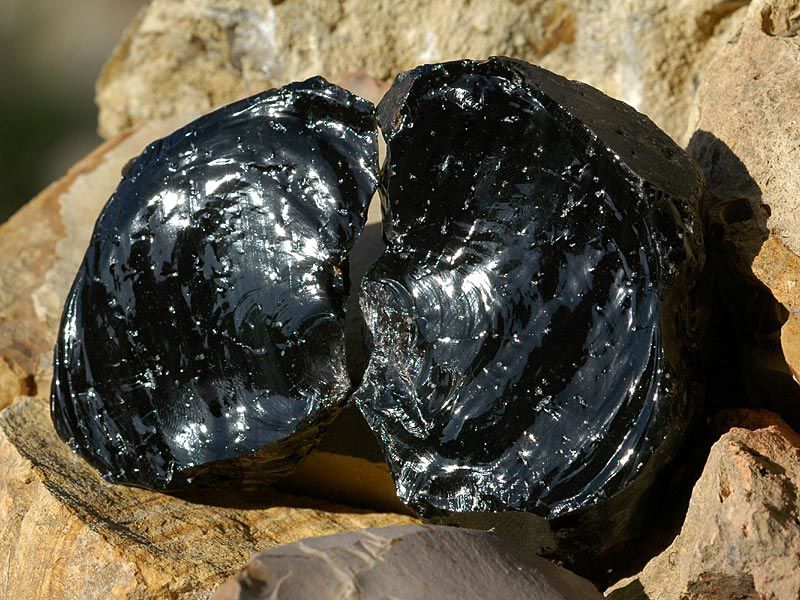Actualité volcanique, Articles de fond sur étude de volcan, tectonique, récits et photos de voyage
Par Bernard Duyck
The history of obsidian merges with the history of early man . This volcanic glass was among the preferred raw materials from the Paleolithic , both for its technical qualities for the realization of effective tools, that for its aesthetic qualities . It will spread very locally first, then will accompany the colonization of new territories, and the creation of new trade roads.
The physico -chemical properties of obsidian allowed an identification of the sources and traceability by prehistorians of the human movements, exchanges of material, goods and expertise.
Distribution map of deposits of prehistoric obsidian - areas of influence and trade routes in the prehistory - doc . Glassway
The cradle of European civilization is the Mediterranean basin.
The area of influence of Anatolia
The oldest traces of use of obsidian on the Mediterranean rim dated Upper Paleolithic , and are found in caves on the southwest coast of Anatolia. The main sources identified are in Cappadocia, with Gollu Dag, Nenezi Dag and Nemrut Dag . It is found in Neolithic sites , as Catalhöyük .
Obsidian from Anatolian volcanoes will travel south to Palestine, and west to Crete .
Obsidian of the eastern islands come from Melos , with two nearshore sources , Dhemenegaki and Sta Nychia, exploited since the 11 millennium BCE. This Melos obsidian will circulate in the Aegean Sea between 11 ° and 8 ° millennium, certifying maritime trade between pre- Neolithic communities . Then she found in various parts of the Greek mainland and Knossos in Crete.
Obsidian from Giali, less favorable to the production of tools, only appears in the eight millennium , before being used as a semi- precious material at the 2nd millennium, by the Minoans in Crete .
In the western Mediterranean , obsidian is found in thousands of prehistoric sites , along an arc going from the eastern Maghreb , to Italy , southern France and of Catalonia , as well as in large islands , Sicily, Sardinia , Corsica, and the Aeolian archipelago . Exchanges are limited to coastal areas, and exceptionally more than 200 km. from the shore.
The main sources are in Sardinia, the Monte Arci volcanic complex , and three islanders sites : Pantelleria , Lipari in the Aeolian, and Palmarola in the Pontine Islands.
In Pantelleria , the main sources are Balata dei Turchi , south of the island, and Lagio di Venere , north -east . In Lipari, the obsidian is located in the lava flow of Gabellot , while at Palmarola , it comes from the Monte Tramontana and Punta Vardella .
The obsidian of Lipari will spread in the Neolithic to Sicily and Calabria, Puglia and then to the Adriatic , even further north, in Friuli and the south of France . The obsidian of Palmarolla will travel to the Apennines, central Italy , Liguria and the south of France . From Sardinia, it will end up in Corsica and Tuscany. Obsidian from Pantelleria will spread further south to the neighboring islands and the coasts of eastern Maghreb. (see map above)
These areas will gradually spread over time, to wither abruptly, with the advent of the metal Ages , Bronze Age and Iron Age , and the diversification of cultural traditions that accompanies it.
Balkan regions will be supplied at the start of the deposits of the Carpathians , in Hungary and Slovakia.
Southeast of the Mediterranean, an area of circulation moves on both sides of the Red Sea, departing Ethiopians deposits .
The priests of ancient Egypt used obsidian knives in embalming ceremonies . In the absence of Egyptian texts in this field, the writings of Herodotus ( 5th century BC ) report " a sharp blade in Ethiopian stone " in the mummification techniques that appear in the Middle Empire around 2700 BC .
The Metropolitan Museum of Art in New York has in its collections obsidian vases, gold rimmed, dated of 12 ° to 18 ° dynasties, between 1990 and 1293 BC.
It was used to make the eyes of many statues ; the most significant achievement is the funerary mask of Tutankhamun - 1323 BC. JC .
Sources :
- Circulation et origine de l'obsidienne préhistorique en Méditerranée, un bilan de cinquante années de recherche - par Gérard Poupea & al.
- La circulation de l'obsidienne dans le sud de la France au Néolithique - par Didier Binder & al.
- University of London - The Obsidian Evidence for the Scale of Social Life during
the Palaeolithic - by Theodora Moutsiou
Thème Magazine - Hébergé par Overblog









